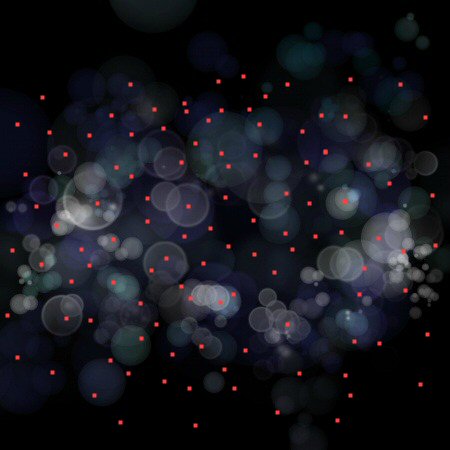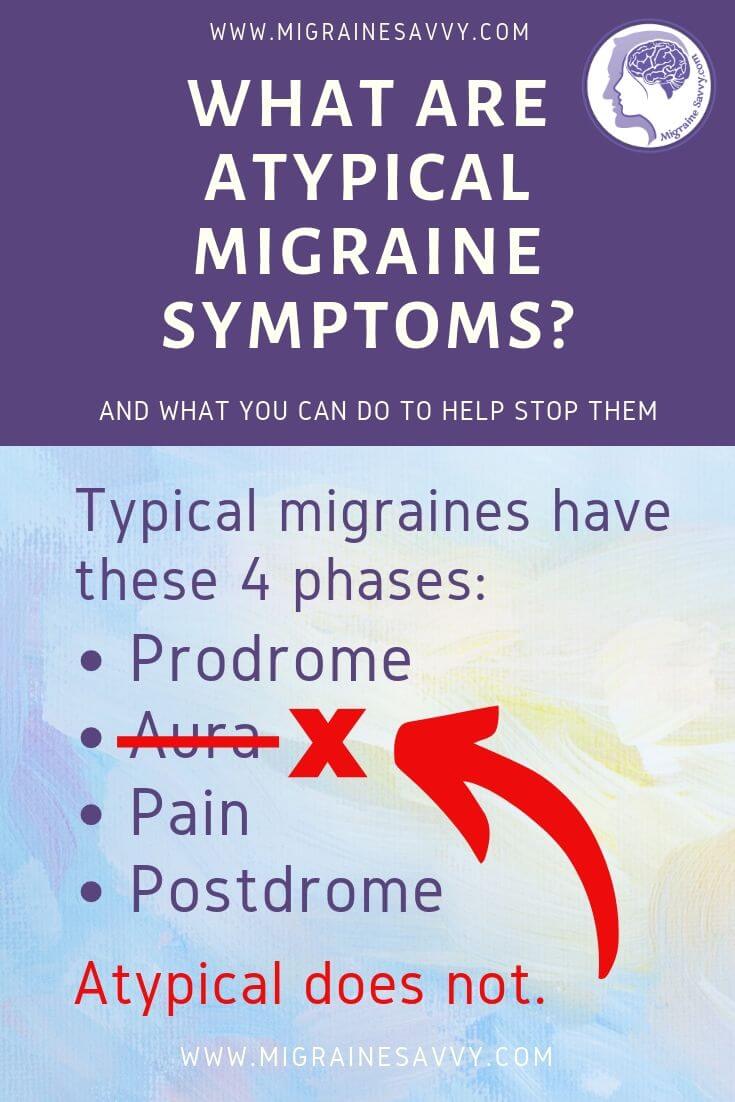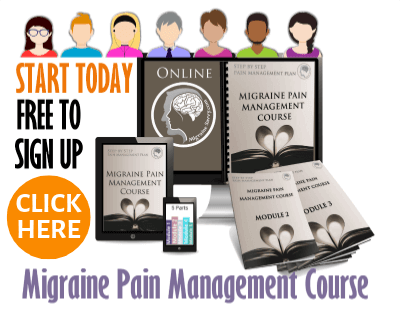- Home
- Migraine Symptoms
- Atypical Migraine Symptoms
COMPLETE MAGNESIUM SUPPORT
My Top Choice - Magnesium Breakthrough - The ONLY supplement with all 7 essential magnesium types in one formula. Most only have 1-2 types, leaving you deficient.
Atypical Migraine Symptoms: What Are They And How To Stop Them
What are atypical migraine symptoms? How do you stop them? What treatment is available? Keep reading to find out how to stop or at least reduce these unusual and uncommon migraine symptoms. And get some super helpful tips on how to alleviate some pain and discomfort.

Physicians often have a difficult time differentiating between a typical and an atypical form of a migraine. We are all so unique and each migraine attack can be different from the last one sometimes.
Severe headache pain is often considered to be a migraine, but the difference between these two types of headaches is usually made based on the lack of one or more of the classic migraine phases (that have different symptoms in each phase).
For example, there are times with the atypical form that there is not even a headache phase. And there are times when it cycles through the stages, and then times when it does not. Confusing... right!
The good news is that with the atypical migraine symptoms: medications, rest, proper diet, and proper nutrition can help to alleviate them. YAY!
My #1 Choice in Magnesium Supplements
First, What Is an Atypical Migraine?
Atypical migraines are a variation of migraine disorder that don't follow the typical pattern. Unlike classic migraines, they don't include the aura phase. Instead, they can present with a range of symptoms beyond the usual headache.
A typical migraine attack normally has 4 phases: prodrome, aura, pain and postdrome. Some organizations note 5 phases: premonitory or prodrome, aura, acute, resolution and postdrome. This final phase is called the interictal phase, which is a medical term that means between episodes or attacks.
Before, during and after the phases you could experience any combination of these accompanying symptoms: nausea or vomiting; mood changes; headache; sensitivity to light sound or smell.
An atypical migraine attack can miss the aura phase. This phase normally includes visual disturbances like flashing lights or blind spots, tingling in the limbs.
So, this means no early warning signs. The attack can often dive straight into the pain phase - the headache phase without much warning.

What Are The Symptoms of an Atypical Migraine?
- Visual Disturbances.
Sometimes before a migraine hits, you might experience what's called an aura, which can include seeing spots, flashes, or even temporary vision loss. Impaired vision includes blurred vision or changes in perception. - Nausea or Vomiting.
Feeling queasy isn't just for stomach bugs; it can also be a migraine in disguise. - Sensitivity to Light and Sound.
If you suddenly can't stand the brightness of your phone screen or the sound of people talking, a migraine might be knocking on your door. - Numbness or Tingling.
An arm or leg feeling like it's gone to sleep can actually be a migraine showing up in a less common way. - Difficulty Speaking.
Finding words more slippery than usual? This can be a migraine symptom, too. - Dizziness or Vertigo.
Feeling like the room is spinning isn't always about being dizzy with love; it can be a migraine symptom. - Mood Changes.
Suddenly feeling irritable or unusually down? Yep, it could be a migraine. - Diarrhea.
Unusual bowel movements, including diarrhea, may accompany these migraines. - Fever.
Although less common, some individuals may develop a low-grade fever during an atypical migraine. - Sinus Pressure.
Atypical migraines can cause sinus discomfort or pressure, even if there's no actual sinus infection.
The symptoms can last from a few hours to a few days, leading to prolonged discomfort... making it difficult to work or participate in your normal activities.
Let's look a little closer at some of these.
Random Visual Disturbances

Although an atypical migraine normally misses the aura phase, you may have a few cycles with them which can get confusing. Here's what to watch for...
These can include visual disturbances such as seeing rainbow-like colors around objects.
They make you see black dots in your vision which seem to float.
I get little orange spots inside the black dots that float around.
Zig-zag patterns occur with atypical migraines as well as with typical headaches.
Flashes of light tend to appear from the peripheral vision. These issues often come with over sensitivity to light.
Abdominal Issues
The most common symptom which is associated with migraines is of course, a headache. It is common though, for sufferers to also have cramping and abdominal pain. This pain is related by women sufferers of atypical migraines as the pain experienced with menstruation.
The digestion process is affected during a migraine that can cause some abdominal issues like cramping, diarrhea and or constipation. You might like to read my article on digestion problems if this is an issue for you.
The atypical migraines are difficult to diagnosis because of the lack of uniformity of the symptoms. These symptoms often resemble other conditions and a physician may make several attempts to diagnose the actual problem.
Facial Pain
Many people, who have atypical migraines, complain of intermittent or constant facial pain. This pain is often the worse around the eyes. Sensitivity to facial touching can sometimes be alleviated by massage.
If this pain occurs around the area of the mouth or jaw, seek help from a physician to be sure there is not another problem, such as an abscessed tooth, trigeminal neuralgia or temporomandibular joint disorder, which could also be causing the problem.
Neurological Numbness
At times, if a person is experiencing an atypical migraine, it can show symptoms similar to a stroke. Numbness and even paralysis in an arm or one side of the body, has been experienced.
These symptoms do not usually last more than a few minutes and leave no side effects. Some patients have reported a tingling on one side of the body which lasts only a few minutes and then gradually disappears.
What's The Best Treatment for Atypical Migraine Symptoms?
Atypical migraine symptoms are treated the same as typical migraine symptoms. The symptoms can be helped by bed rest and over the counter medications containing ibuprofen or acetaminophen.
Many people living with this type of migraine report that a cool, dark, peaceful room is conducive to basically, "sleeping off" the migraine. If the symptoms become severe, seek medical attention.
The diagnosis of the atypical migraine is difficult. The physician may need to perform a variety of tests, log the present symptoms, and take a complete medical history, in order to attempt to make the correct diagnosis.
Try not to get frustrated, because this can often take time and several attempts. You might like to keep a migraine diary or journal. Once the diagnosis is deemed correct, the physician may prescribe a triptan medication, which works basically by balancing the chemicals in the brain.
With atypical migraine symptoms: medications, rest, proper diet, and proper nutrition can help to alleviate them.
P.S. Try this full spectrum magnesium... I LOVE it.
My #1 Choice - Magnesium Breakthrough by BiOptimizers - combines 7 types of magnesium in a humic/fulvic monoatomic blend to optimize absorption. This is by far the best product I have found so far in terms of results.
How To Stop Atypical Migraine Symptoms
How to stop them really depends on what symptom you are having and how proactive you want or can afford to be. $$$$
If you just get the visual disturbance, for example, no pain, just the one symptom, then being able to rest for thirty minutes to an hour might be all you need for it to pass.
The whole right side of my face used to swell up, and it would go back down again as soon as I drank two short black coffees. I know, very sexy right!
As I am no longer able to use coffee for a migraine abortive, I use ice packs for migraine relief now combined with medication, meditation and bed rest. And in between I stay proactive with vitamin supplements and yoga.
Limit or remove contact with any of your known triggers, take immediate action at the onset of any symptoms, and work closely with your doctor if more effective prevention measures are needed to trial prescribed medications.
Be sure to work closely with your doctor to develop a good solid pain management strategy to limit the number of atypical migraine symptoms and attacks you have.
If you want some shortcuts to help you save time and money... you might like to try one of my courses. You can enroll in the Pain Management course for free.
 Atypical migraine relief tips @migrainesavvy
Atypical migraine relief tips @migrainesavvyTips to Help Alleviate or Stop Them
Always check with your doctor first, but here are a few things I recommend:
- Find a Quiet, Dark Room.
As soon as you notice symptoms, try to retreat to a calm, dimly lit environment to lessen sensitivity to light and sound. - Apply Cold or Warm Compress.
Depending on what feels better, apply a cold or warm compress to your head or neck to help soothe the pain. - Stay Hydrated.
Drinking plenty of water can sometimes help ease migraine symptoms or prevent them from getting worse. - Practice Relaxation Techniques.
Deep breathing, meditation, or gentle yoga can help manage stress levels, which might reduce the frequency or severity of migraines. - Limit Screen Time.
Since screens can be a trigger, try to take regular breaks from your computer, phone, or tablet, especially if you're prone to visual disturbances. - Consider Caffeine.
For some, a small amount of caffeine can help alleviate migraine symptoms but be cautious as too much might make things worse. I've written all about that here - Caffeine: a gift or curse. - Seek Professional Advice.
If migraines are a regular part of your life, talking to a healthcare provider can help you find a treatment plan that works for you, including possible medication or therapy options.
For the visual symptoms, bed rest might bring the best relief.
For abdominal issues you might consider peppermint gel caps to settle your stomach, ginger tea or massaging a few drops of essential lavender oil in a carrier oil (olive oil is fine) into your tummy. You can try a mix of lavender and peppermint essential oils too if you'd like. Here's my ginger tea recipe.
For the facial pain and neurological symptoms, please see your doctor asap. Try Gelsemium Oligoplex, a homeopathic tincture for symptoms of neuralgia and headache. It did not work for the intensity of my pain, but if your atypical migraine symptoms are mild or moderate, it might work VERY effectively.
Remember, you know your body best. Keeping a diary of your symptoms can help you identify triggers and effective relief strategies. Sharing this with your healthcare provider can also tailor a plan that suits your specific needs. Hopefully, these tips offer some relief and make those horrible migraine attacks a bit more manageable!
There's no cure for migraine (yet), so get the right guidance and the right pain management strategy to help you find relief faster. My pain management course can help you step-by-step to get your best results. Here's the link. The first module is FREE.
Until next time, be well.
WANT MORE TIPS? Subscribe to my newsletter and follow along on Facebook and Pinterest for all of the latest updates.
MIGRAINE SYMPTOMS Related Articles
How to be more MIGRAINE SAVVY right now...














